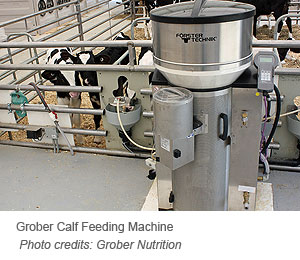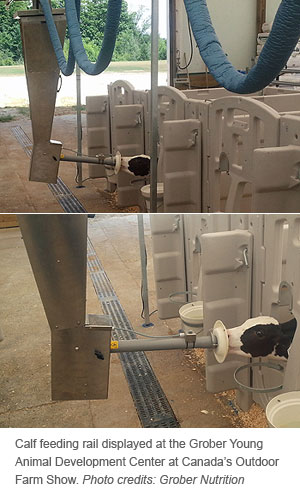Healthy Calf Conference
Follow to stay up-to-date on all Healthy Calf Conference updates. Speaker announcements, sponsorship information, registration announcements, and more.
Part of a calf’s natural behaviour, say animal welfare experts, is consuming multiple smaller meals throughout the day. Automated feeding machines, which are starting to attract interest in Canada, let calves express that natural behaviour but will require some changes in how producers manage their herds.
“One of the main advantages of the automated feeders is they allow a calf to drink the way mother nature intended, with multiple smaller meals throughout the day,” explains Dr. Nancy Charlton with DeLaval Canada. “The calf can drink what it wants and when it wants. We aren’t imposing our thinking but allowing the opportunity to express natural behaviour.”

Calves can start feeding from a machine three to seven days after birth and producers can program the machine’s software to determine how much milk a calf can consume in a day. Holstein calves can drink up to 12 litres daily but most will average eight to 10 litres a day, says Charlton, and they should have the opportunity to drink more in the fall when temperatures become cooler.
Feed freshness is another advantage, says Jan Ziemerink, a computer feeding specialist with Grober Nutrition and Förster-Technik North America, the world’s largest manufacturer of automatic calf feeders.
“The machine mixes the portions when a calf enters so they’re always fresh and the temperature is kept up,” he explains, adding that the new machines now have automatic calibration which ensures each portion gets the right amount of water. “Feed components are always dosed precisely and the blender means the mixing of the milk replacer is very accurate.”
Machine feeding allows producers to check milk consumption and drinking speed of calves and send all data collected by the machine to specialized software that can be analyzed and used to make herd management decisions.
“Drinking speed is important because you can see if calves will get sick before they actually show signs. The machine keeps track of drinking speed over the last few days and gives you an alarm if an animal is drinking slower,” he says. “This could be an early indicator of illness so you can check calves and instead of medication, vitamins or electrolytes might do the trick.”
Machines also make weaning process easier, says Charlton, as calves’ milk intake is reduced gradually. This lessens calf stress, which in turn decreases incidences of pneumonia and post-weaning sickness.
But although the automated feeders may free producers from a regimented, twice-daily feeding schedule, both Ziemerink and Charlton stress the importance of continued hands-on calf management.
“You still have to manage the machine and you still have to come to the barn twice a day – you become a manager instead of a feeder,” says Ziemerink.
“Machines aren’t a license to walk away and not look at your calves. You still have to have a daily routine and learn how to manage the calves with the technology,” adds Charlton.
Producers must also continue to pay attention to the basics, like good air flow, colostrum management and a dry, clean environment. It’s also important to maintain contact with the calves to help identify which ones might need individual attention.
“Ventiliation is the number one focus point. If there is no ventilation, you can put any kind of machine in the barn and you will still have sick calves,” advises Ziemerink, who encourages producers to walk through the calf pen at least once per day to check all calves objectively and not just the ones identified by the computer.

“With pail feedings, producers rely on how much a calf drinks per feeding but now you must also observe other behaviours for clues such as droopy or dull appearance or standing away from other calves,” adds Charlton.
An automatic calf feeding system is now available for individually housed calves in Canada as well. Grober Nutrition and Förster-Technik unveiled the CalfRail at the Grober Young Animal Development Centre as part of Canada’s Outdoor Farm Show 2013. Feed is pumped through a hose connected to a moving arm that moves along an overhead track from calf to calf.
Follow to stay up-to-date on all Healthy Calf Conference updates. Speaker announcements, sponsorship information, registration announcements, and more.
The Codes of Practice are nationally developed guidelines for the care and handling of farm animals. They serve as our national understanding of animal care requirements and recommended practices.